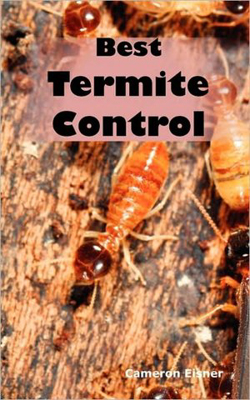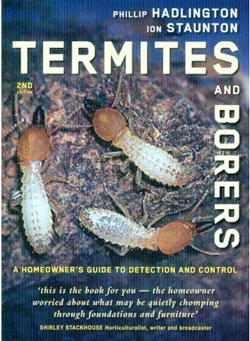
Termites and Termite Control
Termites
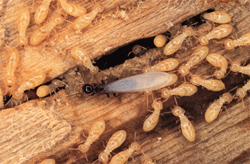
Worker Termites
Image credit: Va Tech
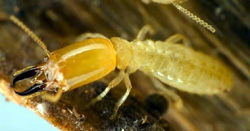
Soldier Termite
Image credit: Tecca
Termites are social insects that form colonies that can number in the hundreds or thousands of individual members. Member categories include egg laying queens, workers and soldiers.
Termites, in or around your home, are significant pests. They can cause serious structural damage to homes and buildings. Termites feed mostly on cellulose, generally in the form of wood. Their recycling of wood such as dead trees is of considerable importance. However, when the wood they choose is part of your house, or other building, this can be a very serious problem. They especially attack wood that is in contact with, or close to the ground. They will also eat books, papers, photographs, documents, or anything else made of cellulose (wood or wood pulp).
Damage They Do
Because termites feed on wood, they can infest and ruin structural members of your home. Often they can be in the wood beams that are out of sight. It takes careful inspection to spot the presence of termites.
You might have termites if you see the following signs in your house: Sawdust-like droppings, dirt or mud-like tubes on the structure, damaged wood members, swarming winged insects within the structure in the spring.
When buying a home, a termite inspection is often required by the buyer and/or bank providing a mortgage. Any termite damage found must be repaired, and the presence of termites eliminated, before the sale can go through.
Identification
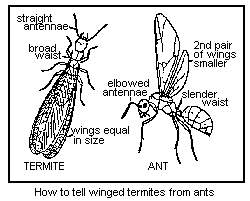
Termites vs Flying Ants
Image credit: ukAg
In the spring termites swarm and fly around. The swarmers then drop to the ground, shed their wings, and pair off with a mate in an attempt to start a new colony. Few colonies ever start, but some do. Often when you think you see swarming termites they turn out to be flying ants. They look similar, but flying ants have a very narrow waist while termites have a broader waist. See the figure to the right.
If you see termites swarming outside and they are not too near your house, then your house is probably still safe. They might be from nearby woods or other decaying wood on your property, or even from hardwood mulch. However, if you see them swarm inside your house, then you probably have trouble.
We have seen termites swarm outside of our house, but they were coming from hardwood mulch in our gardens that was, fortunately, not up against the house. We no longer use hardwood mulch. Instead, we stick to licorice root mulch or cedar bark mulch to avoid attracting termites too close to the house.
Termite Control
Keep the ground near the house foundation clear of leaves and hardwood mulch.
Do not stack firewood against the house. Remove piles of lumber or other wood clutter from around the house and from under decks.
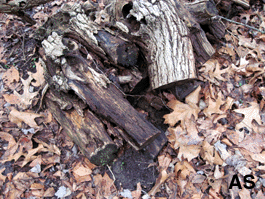
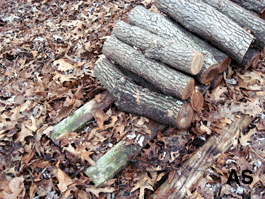
If you stack firewood on your property, don't stack it directly on the ground like the picture on the left. You are inviting termites. Stack firewood on treated lumber rails as shown on the picture on the right.
Always keep an eye out for termites, and be vigilant. If you think you may have termites, call in a professional exterminator for a verifying inspection.
If you are building a deck with wooden posts that go into the ground, make sure the posts are made of treated lumber that will resist termites.
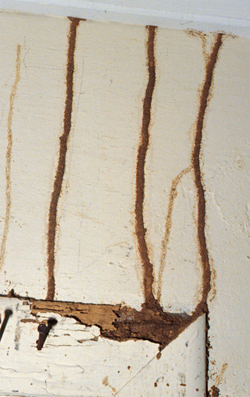
Termite Tunnels
Image credit: Va Tech
Since termites are soft-bodied and do not have the same hard outside skeletons as ants, they live underground for protection. They must always stay away from extended exposure to outside air or else they will dry out and die. In order to move from an area underground to a food-source above ground, they will construct their own mud passageways in order to be able to maintain their lifeline route back into the moist soil.
A scary thought: Termites can bridge an air gap between the ground and wood members of your home above a cement sill or a wall. They do this by constructing dirt tunnels they create out of mud. The tunnels protect them from predators like ants, and prevent them from dehydration while still keeping their vital contact route back into the ground.
Here is another scary thought: Termites can work their way right through cinder block because it protects them from the outside air while still being porous enough to crawl through. Since cinder block is used in most house and building foundations, a barrier is required between the top of a cinder block foundation wall and the wood runners that are the base of the building walls and all wood beams above. In the previous house we owned, copper sheet was used for the barrier. In our present home, asbestos roof shingle was used. Probably not as good as copper, which supposedly gives soft-bodied insects a galvanic shock. (This is why copper strips in the garden supposedly repells slugs on your plants.) Another barrier often used in homes is thick tar paper.
When inspecting your home, be on the lookout for termite mud tunnels and channels.
Elimination - Use a Professional Exterminator
If you do find evidence of termite infestation, don't try to treat or eliminate the infestation yourself. The chemicals (liquid termiticides) used to destroy termites are potent and very dangerous, and a single treatment may require many gallons. We recommend that you call in a professional exterminator. They have the know-how, the equipment, the correct insecticides and the protective clothing. They know the ratio dosages, how not to breathe it in, and what needs to be done. We suggest that you let them do it; they are trained to do it right.
References
Termite Control: Answers for Homeowners
University of Kentucky College of Agriculture
Mike Potter, Extension Entomologist
Subterranean Termite Biology and Behavior
Virginia Cooperative
Extension, Virginia Tech
Dini M. Miller, Associate Professor and Extension Specialist
Books About Termites and How to Control Them
Best Termite Control
- by Cameron Eisner - 2010
This book is a complete guide to termite control. The author put everything he knows about termites and how to get
rid of them into simple, understandable language so you can easily learn all there is to know about termite control.
If you have termite problems or want to learn more about termite control, but didn't know where to start, then I encourage you to learn
from the author's experience and get started on the right footing. This book contains everything you need to know to help you keep your
house safe from termites!
Termites and Borers: A Home Owner's Guide to their Detection, Prevention and Control
- by Phillip W. Hadlington - 2006
A consumer-oriented and compact handbook written in plain English for a general audience with an interest in protecting their home against termites (and other timber pests such as borers). The revision brings the book right up to date, discussing new termite detection techniques, as well as treatment options for termite infestations.
